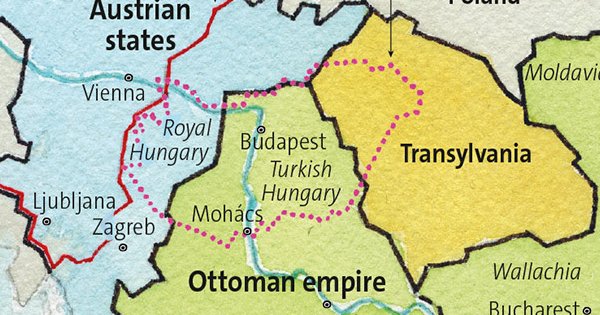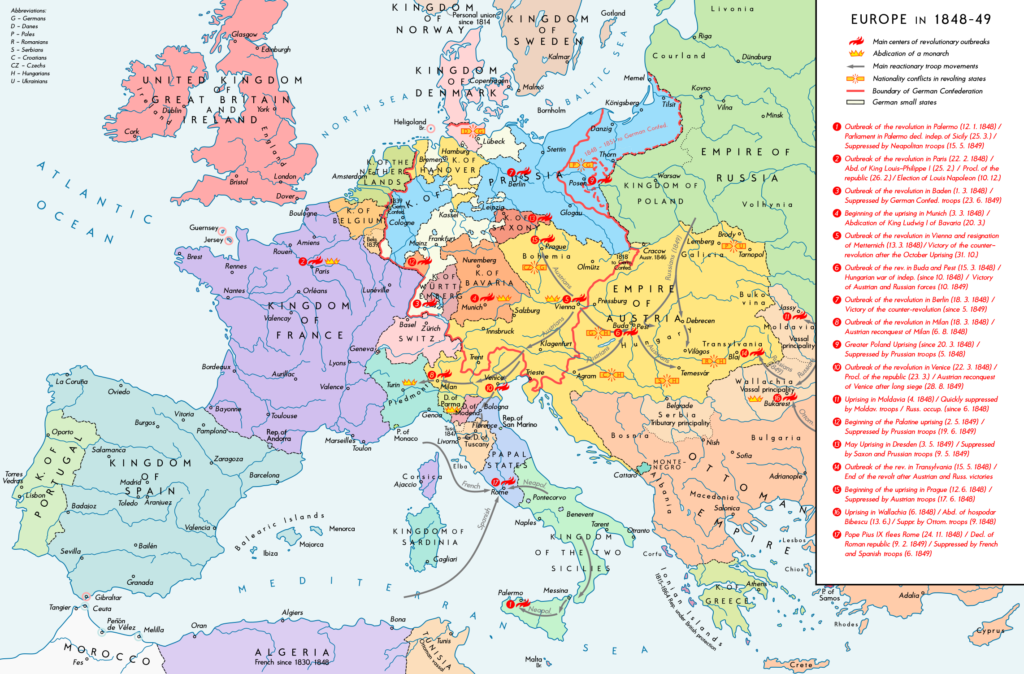In our last episode, Suleiman had killed King Louis and installed Janos (John) Zápolya as his vassal King of Hungary. Meanwhile, at the Diet of Bratislava, Ferdinand I, Holy Roman Emperor who was also Archduke of Austria was declared King of Hungary. Two facts underpinned the legitimacy for the Diet taking this step. First, Ferdinand was related to Louis by marriage. Second, formal agreements existed stating that the Habsburgs would take the Hungarian throne if Louis died without heirs. The surviving nobles of Hungary now had to choose between pledging allegiance to a native who was a vassal of Suleiman or to a “foreigner” albeit a Christian one.
While Ferdinand controlled part of the western territory,

Zápolya ruled a geographically larger part of the country (largely under Ottoman suzerainty) as King John I until his death in 1540 at which point Hungary was split more formally into three parts. This division lasted until the end of the 17th century. The northern and western territories where Ferdinand was recognized as king became known as Royal Hungary. Ottoman Hungary constituted most of the territory we recognize as Hungary today. It also included the Eastern Hungarian Kingdom which was ruled by descendants of Janos Zápolya and later known as the Principality of Transylvania.
But the Ottomans weren’t done in their attempts to probe ever deeper into Europe and Ferdinand, pushing back, tried to assert his rule over as much of Hungary as he could. This back and forth kept the region in turmoil for nearly a century and a half. The culmination of the fighting began in 1683 when the Ottoman Grand Vizier Kara Mustafa Pasha convinced the Sultan Mehmet IV to lay siege to Vienna. Like Suleiman’s failed 1529 attempt, Mehmet’s siege also failed and the Habsburgs went on the offensive. By 1686 Buda was free of Ottoman influence.
The wars between the Habsburgs and the Ottomans officially ended with the signing of the Treaty of Karlowitz in 1699. The Ottomans ceded much of the territory they had taken from the medieval Kingdom of Hungary to the Habsburgs and that family now administered a much-enlarged territory than the area called Royal Hungary they had previously controlled.
You say you want a revolution
However, the Hungarians were no happier being ruled by the Habsburgs than they’d been being ruled by the Turks. It wasn’t long before the Hungarians launched a war for their independence. Led by Francis II Rákóczi, the war that lasted from 1703 to 1711 is known as Rákóczi’s War for Independence. When the Hungarians lost in this independence effort, their defeat shifted the country’s ethnic balance.
With large areas of the country devastated by the wars with the Turks and Rákóczi’s War for Independence the Habsburgs tried to resettle depopulated areas mainly with large groups of Serbs and other Slavs in the south and Germans in the rest of the country creating large pockets of ethnic minorities. Still, ethnic Hungarians balked at Habsburg rule. They were granted a superficially independent administrative structure nominally retaining their own Diet (Parliament) and constitution. The reality was that the Austrians controlled governmental decisions and, more importantly, the purse strings. Hungary never became fully integrated into the Habsburg empire.
The situation was reasonably quiet for about a century and a half until the landmark year of 1848. This map by amateur historian Alexander Altenhof summarizes what happened. (You might want to click on it to enlarge it.)
This was the year of European Revolutions. Number five on the map indicates the revolution in Vienna that began with the resignation of the Chancellor of State Prince Klemens von Metternich on 13 March 1848. Two days later, on what is now a national holiday in Hungary, the Hungarian Revolution of 1848 began with a series of demonstrations in Buda and Pest.
One of the major people at the center of this movement was Lajos (Louis) Kossuth who had been agitating for Hungarian independence for nearly a decade. Kossuth used the news of the March third uprising in Paris to give an impassioned speech about freedom and human rights in Vienna on 13 March. News of his speech spurred a peaceful march that began in Pest and finished at the office of the Governor-General in Buda where he acceded to the 12 points the marchers demanded.
Faced with its own problems in Vienna, the Austrian monarchy initially made concessions to the Hungarians that allowed the Governor-General to call for a new parliament and appoint Lajos Batthyány as the first Prime Minister. Despite enacting substantial reforms, Batthyány wanted to maintain something akin to a constitutional monarchy. By early summer, the leadership sensed the very real possibility of civil war and saw a particular threat coming from the south that was led by Josip Jelačić (the Croatian hero whose name I hope you remember from my time in Zagreb) who was a count in Croatia and Dalmatia which were at that time part of Hungary.
What had started as a peaceful revolution rather quickly became a three-front war with Jelačić and his Croatian troops to the south, Romanians to the east, and Austrians to the west. Although the newly formed Hungarian Revolutionary Army managed a morale building victory over the Croatians at the Battle of Pákzod pushing them away from Buda and toward Vienna, Batthyány resigned as Prime Minister and was eventually replaced by a government led by Lajos Kossuth whose inability to deal fairly with the ethnic minorities would have serious consequences.
I’ll reveal exactly what those consequences were in part three.
